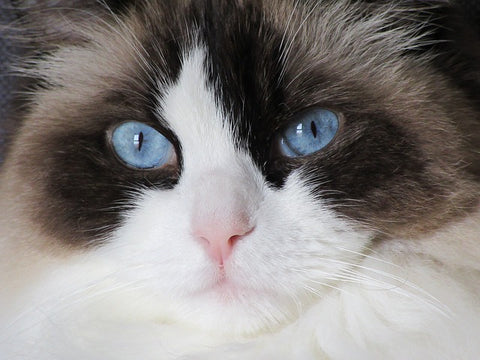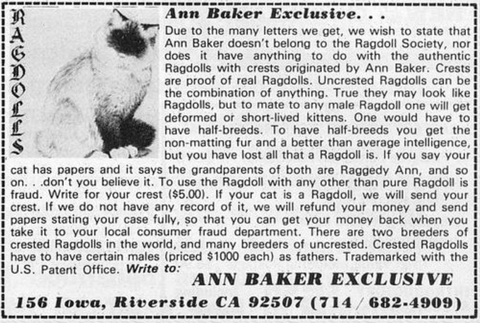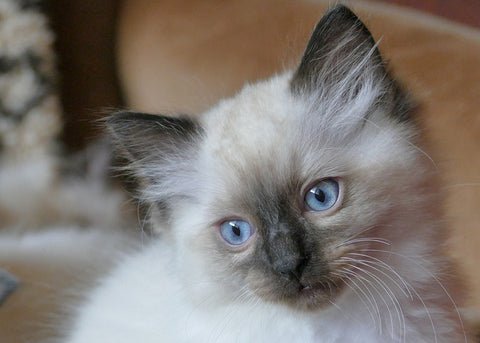What is a Ragdoll cat?
The Ragdoll’s nickname is “puppy cat,” which makes me want one immediately.
An early ad, in the 1973 edition of Cats Magazine, describes the Ragdoll as the “Pacifist Cat” and describes this kitty as “3 feet of love.” Now I want two.

This is a follow-you-around the house, flop-at-your-feet, rub-my-soft-belly kind of cat. This is a cat to take on road trips, to share your pillow with, and to take on leashed strolls around the neighborhood.
This is an unusual cat for sure. But it’s not just about the Ragdoll’s personality. His fabulous personality comes wrapped in a stunning and sparkling-blue-eyed package. There’s nothing not to love about a Ragdoll.
What is the history of the Ragdoll cat?

There are some cat breeds, like the Norwegian Forest Cat, that have been around for millennia. And then there are others, like the Ragdoll cat, that have been around for five minutes, relatively speaking.
This is a very new breed and yet there’s still a fascinating, and frankly, kooky backstory, involving aliens and secret DNA experiments. Well, not really.
The story starts with Josephine, a feral and not very friendly cat, who hung around the neighborhood in Riverside, California during the 1960s. She had no pedigree; she was just a white, domestic longhaired street cat, probably of Persian or Angora stock.
Until she was hit by a car.
After the accident, some neighbors claimed her, took her in, and got her the veterinary care she needed. Then, at some point later, she had a litter of kittens who were noticeably more docile than their mom.

Who noticed how docile they were? Ann Baker, one of the neighbors’ neighbors, who “borrowed” some of these lazy kittens and bred them. Can you imagine? She borrowed and then bred kittens belonging to a neighbor.
Baker had some off-the-wall ideas about why the kittens were so docile. She thought that Josephine’s genes were “rearranged” by the car accident. That’s not scientifically possible, in case you were wondering.
She also thought that a local university might have been conducting secret experiments on the cat.[1] Also not true. Obviously.
This eccentric woman had some other bizarre ideas involving her cats. She claimed that her cats were the last link between aliens and humans. She claimed that her cats felt no fear and didn’t experience pain. She also believed they’d been hybridized by skunk genes.
Anyway, Josephine had two baby daddies: a black male Birman or Burmese-type of cat named Blackie, and a cat with Siamese-point coloration and white feet named Daddy Warbucks. These matings produced two females: Fugianna and Buckwheat.
Thanks to Ann Baker, Daddy Warbucks was bred to both girls and all Ragdoll cats today are descendants of those couplings.
The kittens from all of Ann Baker’s litters were all docile, placid, affectionate, and large cats, just like most Ragdolls today.
Ann Baker and her problem with cat associations

Baker wanted nothing to do with cat-breeding associations. She trademarked the name Ragdoll and founded her own registry in 1971 that she called The International Ragdoll Cat Association (IRCA). She established strict standards for anyone who wanted to breed or sell cats under the Ragdoll name. She wouldn’t allow Ragdolls to be registered by any of the other breed associations, and consequently, they were never shown at any cat shows.
By 1975, a group of Ragdoll owners had had enough of Baker’s rules. They established the Ragdoll Society and worked hard to get the breed recognized by mainstream breed associations like The Cat Fanciers’ Association (CFA), The International Cat Association (TICA) and American Cat Fanciers Association (ACFA) so they could begin showing the cats.
Baker was probably not happy about this turn of events. She took an advertisement out in Cats Magazine in 1977 suggesting that purchasers of these “uncrested” or “fake” Ragdolls should contact their local consumer fraud department. She claimed mating “fake” Ragdolls would produce “deformed or short-lived kittens.”

The Ragdoll Society founders were not the only Ragdoll lovers to take issue with Baker’s unbending IRCA rules. In 1994, a second group left IRCA to establish a new breed they called “Ragamuffin” because Baker still owned the rights to the name Ragdoll. By 2005, however, the Ragdoll trademark was allowed to expire.
Why did Ann Baker call her cat breed “Ragdoll?”
Supposedly, the kittens of Josephine’s litters had a tendency to go limp when they were picked up. These kittens were floppy, like a child’s toy ragdoll, or so the story goes.
Look, this is a laaaaaaazzzy cat, but there isn’t anything in a Ragdoll’s biology that would make them go limp. There are some animals that do spontaneously seem to fall over, like Fainting Goats (which have a medical condition called myotonia congenita, which actually causes them to tense up and flop). But Ragdolls have no such condition.
If you peruse the videos of “limp” Ragdolls on YouTube, you’ll find a lot of lazy cats lolling about. But they are simply relaxed, not limp. Do not be concerned if your new Ragdoll kitten does not “go limp” when held.
What does a Ragdoll cat look like?

Beau of @Ragdolls_Belle_and_Beau
The Ragdoll is a beauty, there’s no doubt about it. She’s large and muscular, with semi-long hair, and a soft and silky plush coat.
A Ragdoll has the most brilliant blue eyes. Occasionally, a Ragdoll may have only a single blue eye, and that can sometimes indicate deafness on the non-blue side.[2]
(Read about deafness in cats in this post.)
The Ragdoll is one of the largest domesticated cat breeds. Females typically weigh 10-15 pounds and males are 15-20 pounds.[3] That’s a whopping big cat!
Ragdolls come in four different patterns and six different colors. The pattens include:
Colorpointed, which means they are all one color, but with darker fur on the nose, ears, and paws.
Mitted, which is the same as color-pointed, but with white paws and a white belly stripe that extends from the cat’s chin to her genitals. Mitted cats may also have a blaze (white stripe), spot, or hourglass-shape on the face.
Bi-color, in which the cat has white legs, an upside-down “V” on the face, a white belly, and sometimes white patches on the back. If there’s a lot of white, the coloring is called “high white” or “van.”
Blue-pointed, which usually means the body is a light platinum with dark bluish-gray points. Sometimes the chest and stomach are also bluish-gray.
The six colors include: red, seal, chocolate, and their “dilutes” which are blue, lilac, and cream.

On top of all of these confusing color/pattern combinations, a Ragdoll’s points can be solid-colored, lynx (tabby), tortoiseshell (mottled), or a combination of lynx and tortoiseshell called “torbie.”
Ragdolls are born white. Their coloring starts to show at eight to 10 weeks old, but they don’t get their final coloring until they are three or four years old.
What is a Ragdoll’s personality?

If you want to be left alone, don’t get a Ragdoll. A Ragdoll will follow you around the house like a little shadow, wanting to be included in whatever you’re doing.
A Ragdoll is docile, placid, gentle, and affectionate. These cats love to be held. They’re good cats to have with dogs because they get along with everybody and show no aggression to other pets. They’re good cats to have with children, so long as you have respectful children who know how to behave with cats.
Ragdolls are not athletes. They’re just not that motivated. You’re not going to find yours hanging out on top of the kitchen cabinets, or balancing on the narrow ledge of an open door. These are carpet-surfing cats.

Ragdoll cats are so laidback that one Stanford sleep researcher suggested Ragdolls might be able to help us understand narcolepsy, a disease of unexplained sleepiness.[4]
That doesn’t mean that Ragdolls don’t like to play, however. They can be very playful! And they’re careful to play without extending their claws.[5] How thoughtful.
You can teach your Ragdoll to come when called. You can teach your Ragdoll to fetch. One thing you cannot do is make your Ragdoll an outdoor cat. They’re so relaxed and friendly they wouldn’t hesitate to chum up with a roaming dog or wild animal. These cats are so fearless that some breeders in the United Kingdom are actually trying to breed some of that docility out of them. Now there’s a problem to have.
Do Ragdoll cats have health problems?
One study, based on Swedish insurance data, showed that Ragdolls have among the shortest lifespans of common cat breeds. According to this study, a typical lifespan of a Ragdoll cat is 12-15 years.[6] It’s not clear whether this statistic is true outside of Scandinavia.

While Ragdolls are generally healthy cats, the breed does suffer from hypertrophic cardiomyopathy (HCM), which is a genetic disorder and the most common heart disease in cats. HCM causes a thickening of the heart wall which makes the heart pump less efficiently. It can cause sudden death in a cat, and this can, unfortunately, be the first “sign” that a cat is suffering from this terrible disorder.
We now know the exact genetic mutation that causes this disease. A responsible breeder will screen for it and avoid breeding cats who carry this mutation. But beware of a breeder who promises HCM-free lines. No one can guarantee that a cat will not develop HCM.
How do I care for my Ragdoll cat?
A Ragdoll cat is relatively easy to care for, requiring all the same care that any cat will require.

Their beautiful coats do require a little extra attention, however. Although their fur does not mat easily because it is made up of mostly long, guard hairs rather than a dense undercoat, matting can still occur. Comb them at least twice a week. Use a steel comb to get through any tangles.
Luckily, this is cat who enjoys the attention of being groomed.
Are there any famous Ragdoll cats?
The longest living Janus cat, according to the Guinness Book of World Records, was a Ragdoll named Frank and Louie. Frank and Louie suffered from diprosopus, a congenital disorder in which an animal has duplicated facial features. Janus is the name of the Roman god with two faces.
Frank and Louie lived to the ripe old age of 15, which a kind of a miracle since he was brought to the Cummings School of Veterinary Medicine at Tufts University to be euthanized on his first day of life. A veterinary nurse brought him home instead.
Frank and Louie was born with one brain, two faces, two mouths, two noses, and three blue eyes. His only functional mouth was connected to his esophogus.[7]
Here’s a heartwarming video of this unusual feline during his life.
Enjoy this related post:
How to choose a kitten from a litter
Love Pinterest? Here's a Pinterest-friendly pin for your boards!

Dawn LaFontaine
Dawn LaFontaine is a lifelong animal lover who always seems to have a little pet hair in her keyboard. Her blog, Kitty Contemplations, helps cat guardians better understand and care for the special beings they share their lives and homes with. Her cat-products business, Cat in the Box, sells beautiful, well-made, and award-winning products that she designed to meet the biological needs of cats.
_______________
FOOTNOTES
[1] ASPCA Pet Insurance. “Ragdoll Cat Facts.” Pet Insurance Coverage, ASPCA Pet Insurance, 16 Sept. 2016, www.aspcapetinsurance.com/resources/ragdoll-cat-facts/.
[2] ibid.
[3] “About the Ragdoll.” The Cat Fanciers Association Inc, cfa.org/ragdoll/.
[4] Donnelly, Elisabeth, and Sophie Barbasch. “Valley of the Ragdolls.” Topic, Topic, 7 Feb. 2019, www.topic.com/valley-of-the-ragdolls.
[5] The Cat Fanciers Association Inc.
[6] Egenvall, A, et al. “Mortality of Life-Insured Swedish Cats during 1999-2006: Age, Breed, Sex, and Diagnosis.” Journal of Veterinary Internal Medicine, Blackwell Publishing Inc, 2009, www.ncbi.nlm.nih.gov/pmc/articles/PMC7167180/.
[7] “Frank and Louie.” Wikipedia, Wikimedia Foundation, 1 Mar. 2021, en.wikipedia.org/wiki/Frank_and_Louie.


4 comments
I like it